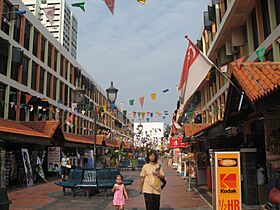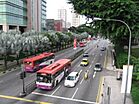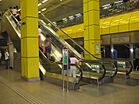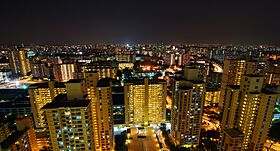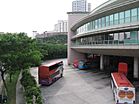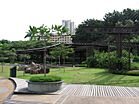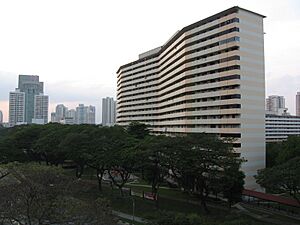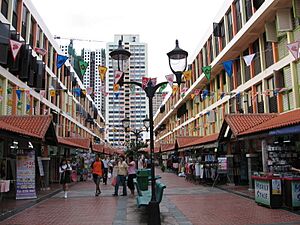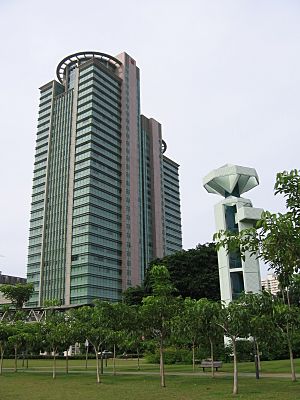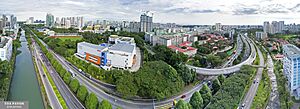Toa Payoh facts for kids
Quick facts for kids
Toa Payoh
|
|
|---|---|
|
Planning Area and HDB Town
|
|
| Other transcription(s) | |
| • Chinese | 大巴窑 (Simplified) 大巴窯 (Traditional) Dàbāyáo (Pinyin) Tōa Pa-iô (Hokkien POJ) |
| • Malay | Toa Payoh |
| • Tamil | தோ பாயோ Tō pāyō (Transliteration) |
|
From top left to right: Toa Payoh Town Centre; Lorong 6 Toa Payoh; Toa Payoh MRT station; Toa Payoh at night with Bishan and Serangoon in the distance; Toa Payoh Bus Interchange; Toa Payoh Town Park
|
|

Location in Central Region
|
|
| Country | |
| Region | Central Region
|
| CDC |
|
| Town councils |
|
| Constituencies |
|
| Area | |
| • Total | 8.17 km2 (3.15 sq mi) |
| • Residential | 2.48 km2 (0.96 sq mi) |
| Population
(2019)
|
|
| • Total | 120,650 |
| • Density | 14,767/km2 (38,247/sq mi) |
| Demonym(s) | Official
|
| Postal districts |
11, 12, 13
|
| Dwelling units | 36,439 |
| Projected ultimate | 61,000 |
Toa Payoh is a busy and well-known residential town in the northern part of Singapore's Central Region. It is one of Singapore's planning areas and a mature residential town. Toa Payoh is surrounded by other areas like Bishan, Serangoon, Kallang, and Novena.
Contents
What's in a Name?
The name Toa Payoh comes from the Hokkien language. It means "big swamp". The word toa means "big", and payoh means "swamp". This is similar to the Malay word paya, which also means swamp. So, Toa Payoh is like the Chinese version of Paya Lebar, which means "big swamp land".
Long ago, Toa Payoh had an old Chinese name: Ang Chiang San. This name meant "burial hill" because there was an old cemetery in the area.
An early government surveyor, John Turnbull Thomson, mentioned Toa Payoh in his reports way back in 1849.
You might notice something special about the roads in Toa Payoh. Many of them have Malay words like Jalan (road) or Lorong (lane) in their names. This is because when the town was first planned, Singapore was part of Malaysia.
A Look Back in Time
Toa Payoh was once a large area where many people lived in simple homes, often without official permission. These residents were called squatters. Many of them worked as farmers, raising pigs. Others were hawkers, factory workers, or helped in homes.
In 1962, the government started helping these residents move out. They offered money and other help. This allowed construction to begin in early 1964.
Toa Payoh New Town is Singapore's second oldest planned town. It was the first one built by the Housing and Development Board (HDB). Before it became a modern town, Toa Payoh was mostly farmland with many simple homes.
British Queen Elizabeth II has visited Toa Payoh twice. She came in 1972 and again in 2006.
Modern Infrastructure
The design of Toa Payoh New Town followed smart urban planning ideas of its time. It was built to be a self-sufficient town. This means it has everything residents need, like shops and entertainment, all in one central area.
Factories were also built in the town. This gave people living there job opportunities close to their homes. Schools were also placed within the different neighborhoods.
Toa Payoh Town Centre
The town centre in Toa Payoh was the first of its kind in Singapore. It's surrounded by different neighborhoods, each with its own shops and community centres. These areas are connected by roads and open spaces. Residents can easily shop in their own neighborhood or travel to the city using the MRT system. The Toa Payoh and Braddell MRT stations, and the Toa Payoh Bus Interchange, make travel easy.
Over time, the Toa Payoh Town Centre has become very popular. It's a lively place where many shops are located along a main walkway. There are also two open areas called plazas. One plaza has a library and a cinema, while the other has a post office.
The HDB Hub is a major building in the Toa Payoh Town Centre. It was finished in 2002. The Housing and Development Board moved its main office here. The HDB Hub has different sections, including shops, a learning centre, and a large underground parking lot. It also includes Singapore's first fully air-conditioned Toa Payoh Bus Interchange, which connects directly to the Toa Payoh MRT station.
Another important building in Toa Payoh Central belongs to Royal Philips Electronics. This company makes medical and electronics equipment. Philips has used this facility for many years to develop products like televisions and DVD players.
You can also find a unique small tree shrine called Ci Ern Ge Temple in Toa Payoh Central. This shrine has been there since the old village days before the town was built.
Toa Payoh Town Park
The Housing and Development Board set aside a large area in Toa Payoh for a beautiful garden park. This was done even though land for housing was in high demand.
The Toa Payoh Town Park used to be called Toa Payoh Town Garden. It was a favorite spot for people to see willows, bamboos, and bright red and yellow Delonix regia trees. In the middle of the park is a large carp pond with a waterfall. There are also islands connected by bridges, making it a lovely place to walk day or night.
The park is protected from traffic noise by a raised area with many Angsana trees. You can also find a children's playground, places to sit, an outdoor chessboard, a tea kiosk, and a tall 27-meter viewing tower.
Part of the park was closed in 1999 to make space for a temporary bus interchange. After the new Toa Payoh Bus Interchange at the HDB Hub opened in 2002, the temporary interchange became a landscaped park. That's when Toa Payoh Town Garden was renamed Toa Payoh Town Park.
Toa Payoh Sensory Park
The Toa Payoh Sensory Park is located along Lorong 5 Toa Payoh and covers about 1.1 hectares. This park is designed to use all your five senses! It's divided into five zones, each focusing on one sense. The park was inspired by similar parks in Japan and opened in October 2009.
Sports and Fun
Toa Payoh has many great sports facilities in its southern central area, close to the town centre. These include the Toa Payoh Stadium, which can hold 3,500 people. The S.League club Balestier Khalsa FC plays its home games here. Next to the stadium is the Toa Payoh Sports Hall and the Singapore Table Tennis Association Academy. There's also the Toa Payoh Swimming Complex, where national swimmers often train.
Besides these main facilities, you can find street football courts, gyms, and basketball courts in different neighborhoods throughout Toa Payoh. The SAFRA clubhouse is also located near Toa Payoh Stadium.
Education
Toa Payoh is home to many schools, providing education for students of all ages.
- CHIJ Primary (Toa Payoh)
- CHIJ Secondary (Toa Payoh)
- Pei Chun Public School
- Kheng Cheng School
- Beatty Secondary School
- First Toa Payoh Primary School
Schools in Toa Payoh New Town
- Cedar Primary School
- Saint Andrew's Junior School
- Marymount Convent School
- Maris Stella High School (Primary)
- Maris Stella High School (Secondary)
- Bartley Secondary School
- Cedar Girls' Secondary School
- Saint Andrew's Secondary School


